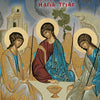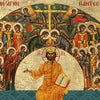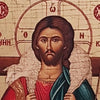The long history of "Panagia Kanakaria” and the restoration of its mosaics

At the occupied part of Cyprus, there is a temple - cultural heritage of Cyprus and the whole world, the Church of Panagia Kanakaria which reflects from the 6th century A.D. to date the history of the place it is located. The church at the village of Lythrangomi in Karpasia is a characteristic sample of the art of the 6th century A.D. and its architectural style is basilica with a dome. The central apse of the temple was decorated with mosaics of the 6th century A.D. which are considered of the few remaining early Christian mosaics in the world.
Except for the mosaics, there were also frescoes in the church dating from the 12th, the 14th and the 16th century. However, only one fresco has survived, that of the Panagia Kanakaria which is located above the southern entrance dating back to the later period. The frescoes were removed between 1978-1979 by Turkish antiquities smuggler Aydin Dikmen and were sold to art dealers in Germany. The incident was reported to the UNESCO, the Council of Europe, the National Council of Museums, the National Council of Monuments and Countries and the Europa Nostra which resulted to the return in 1983 of the stolen medallions with the figures of Apostles Lucas and Bartholomew, which had been removed from the apse of the temple. In 1988 parts of mosaics and works were discovered in the hands of art dealer Peg Goldberg and after a long legal battle they were returned and are nowadays exhibited in the Byzantine Museum of the Archbishop Makarios III Foundation in Nicosia. Similar legal disputes have succeeded in the repatriation of 173 ecclesiastical treasures from 50 looted temples by the Turks at the occupied part of the island.
The mosaics that have been repatriated are among the few of their kind and constitute a thrilling experience for the conservers mainly because these works of art were exported illegally and are now seeking to "revive" in their natural habitat. They have suffered strain and damages due to the violent way with which they were detached and by inappropriate restorations and require multiple interventions, according to Dr. Eleftherios Charalambous, restorer of archaeological finds of the Cyprus Department of Antiquities and head of the restoration group. Lost parts are not replaced by tesserae but by fragments, while the fresco of the Virgin Mary with Child, which face grave problems will need the "intervention" of the group which deals with the restoration of United Nations monuments.
Except for the mosaics, there were also frescoes in the church dating from the 12th, the 14th and the 16th century. However, only one fresco has survived, that of the Panagia Kanakaria which is located above the southern entrance dating back to the later period. The frescoes were removed between 1978-1979 by Turkish antiquities smuggler Aydin Dikmen and were sold to art dealers in Germany. The incident was reported to the UNESCO, the Council of Europe, the National Council of Museums, the National Council of Monuments and Countries and the Europa Nostra which resulted to the return in 1983 of the stolen medallions with the figures of Apostles Lucas and Bartholomew, which had been removed from the apse of the temple. In 1988 parts of mosaics and works were discovered in the hands of art dealer Peg Goldberg and after a long legal battle they were returned and are nowadays exhibited in the Byzantine Museum of the Archbishop Makarios III Foundation in Nicosia. Similar legal disputes have succeeded in the repatriation of 173 ecclesiastical treasures from 50 looted temples by the Turks at the occupied part of the island.
The mosaics that have been repatriated are among the few of their kind and constitute a thrilling experience for the conservers mainly because these works of art were exported illegally and are now seeking to "revive" in their natural habitat. They have suffered strain and damages due to the violent way with which they were detached and by inappropriate restorations and require multiple interventions, according to Dr. Eleftherios Charalambous, restorer of archaeological finds of the Cyprus Department of Antiquities and head of the restoration group. Lost parts are not replaced by tesserae but by fragments, while the fresco of the Virgin Mary with Child, which face grave problems will need the "intervention" of the group which deals with the restoration of United Nations monuments.
-
Posted in
Current Affairs





